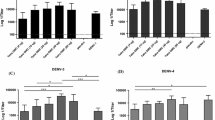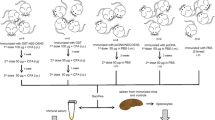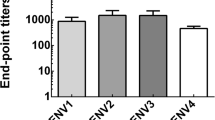Abstract
In this study, we evaluate in mice a novel formulation containing nucleocapsid-like particles of dengue-2 virus (recNLP) co-immunized with a chimeric protein composed of the dengue-4 envelope domain III fused twice within the meningococcal P64k protein of Neisseria meningitidis (PD24). The animals receiving the PD24–recNLP mixture showed the highest levels of antiviral antibodies. Similar results were obtained for IFNγ secretion levels, indicating a functional Th1 cellular response. Consistently, the percentage of mice surviving after viral challenge was significantly higher for those immunized with the mixture than for those inoculated with PD24 protein alone. In addition, in vivo depletion experiments demonstrated the decisive role of CD4+ and CD8+ cells in the protection conferred by immunization with PD24–recNLP. In conclusion, this report demonstrates for the first time the adjuvant capacity of dengue-2 virus recNLP. Additionally, the evidence presented highlights the potential of these particles for enhancing the immune response against heterologous recombinant proteins.




Similar content being viewed by others
References
Edelman R (2007) Dengue vaccines approach the finish line. Clin Infect Dis 45(Suppl 1):S56–S60
Grgacic EV, Anderson DA (2006) Virus-like particles, passport to immune recognition. Methods 40:60–65
Sugrue RJ, Fu J, Howe J, Chan YC (1997) Expression of the dengue virus structural proteins in Pichia pastoris leads to the generation of virus-like particles. J Gen Virol 78(Pt 8):1861–1866
Pushko P, Tumpey TM, Bu F, Knell J, Robinson R, Smith G (2005) Influenza virus-like particles comprised of the HA, NA and M1 proteins of H9N2 influenza virus induce protective immune response in balb/c mice. Vaccine 23:5751–5759
Tacket CO, Sztein MB, Losonsky GA, Wasserman SS, Estes MK (2003) Humoral, mucosal, and cellular immune responses to oral Noralk virus-like particles in volunteers. Clin Immunol 108:241–247
Warfield K, Bosio C, Welcher B, Deal E, Mohamadzadeh M, Schmaljohn A, Aman MJ, Bavari S (2003) Ebola virus-like particles protect form lethal Ebola virus infection. Proc Natl Acad Sci USA 100:15889–15894
Saini M, Gratis S (2003) A Japanese encephalitis virus peptide present on Johnson grass mosaic virus-like particles induces virus-neutralizing antibodies and protects mice against lethal challenge. J Virol 77:3487–3494
Sadeyen J, Toume S, Shkreli M, Sizaret P, Coursaget P (2003) Insertion of a foreign sequence on capsid surface loops of human papillomavirus type 16 virus-like particles reduces their capacity to induce neutralizing antibodies and delineates a conformational neutralizing epitope. Virology 309:32–40
Kang S, Yao Q, Guo LCR (2009) Mucosal immunization with virus-like particles of Simian Immunodeficiency Virus conjugated with Cholera Toxin Subunit B. J Virol 77(18):9823–9830
Alvarez-Lajonchere L, Gonzalez M, varez-Obregon JC, Guerra I, Vina A, costa-Rivero N, Musacchio A, Morales J, Duenas-Carrera S (2006) Hepatitis C virus (HCV) core protein enhances the immunogenicity of a co-delivered DNA vaccine encoding HCV structural antigens in mice. Biotechnol Appl Biochem 44:9–17
Storni T, Ruedl C, Schwarz K, Schwendener R, Renner W, Bachmann MF (2004) Nonmethylated CG motifs packaged into virus-like particles induce protective cytotoxic T cell responses in the absence of systemic side effects. J Immunol 172:1777–1785
Lazo L, Hermida L, Zulueta A, Sanchez J, Lopez C, Silva R, Guillen G, Guzman MG (2007) A recombinant capsid protein from Dengue-2 induces protection in mice against homologous virus. Vaccine 25:1064–1070
Lopez C, Gil L, Lazo L, Menendez I, Marcos E, Sanchez J, Valdes I, Falcon V, de la Rosa MC, Marquez G, Guillen G, Hermida L (2009) In vitro assembly of nucleocapsid-like particles from purified recombinant capsid protein of dengue-2 virus. Arch Virol 154:695–698
Gil L, Lopez C, Lazo L, Valdes I, Marcos E, Alonso R, Gambe A, Martin J, Romero Y, Guzman MG, Guillen G, Hermida L (2009) Recombinant nucleocapsid-like particles from dengue-2 virus induce protective CD4+ and CD8+ cells against viral encephalitis in mice. Int Immunol 21(10):1175–1183
Zulueta A, Hermida L, Lazo L, Valdes I, Rodriguez R, Lopez C, Silva R, Rosario D, Martin J, Guzman MG, Guillen G (2003) The fusion site of envelope fragments from each serotype of Dengue virus in the P64k protein, influence some parameters of the resulting chimeric constructs. Biochem Biophys Res Commun 308:619–626
Hermida L, Rodriguez R, Lazo L, Silva R, Zulueta A, Chinea G, Lopez C, Guzman MG, Guillen G (2004) A dengue-2 Envelope fragment inserted within the structure of the P64k meningococcal protein carrier enables a functional immune response against the virus in mice. J Virol Methods 115:41–49
Bernardo L, Izquierdo A, Alvarez M, Rosario D, Prado I, Lopez C, Martinez R, Castro J, Santana E, Hermida L, Guillen G, Guzman MG (2008) Immunogenicity and protective efficacy of a recombinant fusion protein containing the domain III of the dengue 1 envelope protein in non-human primates. Antiviral Res 80:194–199
Gonzalez S, Alvarez A, Caballero E, Vina L, Guillen G, Silva R (2000) P64k meningococcal protein as immunological carrier for weak immunogens. Scand J Immunol 52:113–116
Perez A, Dickinson F, Cinza Z, Ruiz A, Serrano T, Sosa J, Gonzalez S, Gutierrez Y, Nazabal C, Gutierrez O, Guzman D, Diaz M, Delgado M, Caballero E, Sardinas G, Alvarez A, Martin A, Guillen G, Silva R (2001) Safety and preliminary immunogenicity of the recombinant outer membrane protein P64k of Neisseria meningitidis in human volunteers. Biotechnol Appl Biochem 34:121–125
Zulueta A, Martin J, Hermida L, Alvarez M, Valdes I, Prado I, Chinea G, Rosario D, Guillen G, Guzman MG (2006) Amino acid changes in the recombinant Dengue 3 envelope domain III determine its antigenicity and immunogenicity in mice. Virus Res 121:65–73
Roehrig JT (2003) Antigenic structure of flavivirus proteins. Adv Virus Res 59:141–175
Valdes I, Hermida L, Martin J, Menendez T, Gil L, Lazo L, Castro J, Niebla O, Lopez C, Bernardo L, Sanchez J, Romero Y, Martinez R, Guzman MG, Guillen G (2009) Immunological evaluation in nonhuman primates of formulations based on the chimeric protein P64k-domain III of dengue 2 and two components of Neisseria meningitidis. Vaccine 27:995–1001
Lazo L, Zulueta A, Hermida L, Blanco A, Sanchez J, Valdes I, Gil L, Lopez C, Romero Y, Guzman MG, Guillen G (2009) Dengue-4 envelope domain III fused twice within the meningococcal P64k protein carrier induces partial protection in mice. Biotechnol Appl Biochem 52:265–271
Kawano H, Rostapshov V, Rosen L, Lai CJ (1993) Genetic determinants of dengue type 4 virus neurovirulence for mice. J Virol 67:6567–6575
Clarke DH, Casals J (1958) Techniques for hemagglutination and hemagglutination-inhibition with arthropod-borne viruses. Am J Trop Med Hyg 7:561–573
Morens DM, Halstead SB, Repik PM, Putvatana R, Raybourne N (1985) Simplified plaque reduction neutralization assay for dengue viruses by semimicro methods in BHK-21 cells: comparison of the BHK suspension test with standard plaque reduction neutralization. J Clin Microbiol 22:250–254
Kuhn RJ, Zhang W, Rossmann MG, Pletnev SV, Corver J, Lenches E, Jones CT, Mukhopadhyay S, Chipman PR, Strauss EG, Baker TS, Strauss JH (2002) Structure of dengue virus: implications for flavivirus organization, maturation, and fusion. Cell 108:717–725
Chen Y, Maguire T, Marks RM (1996) Demonstration of binding of dengue virus envelope protein to target cells. J Virol 70:8765–8772
Mune M, Rodriguez R, Ramirez R, Soto Y, Sierra B, Rodriguez RR, Marquez G, Garcia J, Guillen G, Guzman MG (2003) Carboxy-terminally truncated Dengue 4 virus envelope glycoprotein expressed in Pichia pastoris induced neutralizing antibodies and resistance to Dengue 4 virus challenge in mice. Arch Virol 148:2267–2273
Simmons M, Murphy GS, Hayes CG (2001) Short report: Antibody responses of mice immunized with a tetravalent dengue recombinant protein subunit vaccine. Am J Trop Med Hyg 65:159–161
Edelman R, Wasserman SS, Bodison SA, Putnak RJ, Eckels KH, Tang D, Kanesa-Thasan N, Vaughn DW, Innis BL, Sun W (2003) Phase I trial of 16 formulations of a tetravalent live-attenuated dengue vaccine. Am J Trop Med Hyg 69:48–60
Vaughn DW (2000) Invited commentary: dengue lessons from Cuba. Am J Epidemiol 152:800–803
Putnak JR, de la Barrera R, Burgess T, Pardo J, Dessy F, Gheysen D, Lobet Y, Green S, Endy TP, Thomas SJ, Eckels KH, Innis BL, Sun W (2008) Comparative evaluation of three assays for measurement of dengue virus neutralizing antibodies. Am J Trop Med Hyg 79:115–122
Chung YC, Ho MS, Wu JC, Chen WJ, Huang JH, Chou ST, Hu YC (2008) Immunization with virus-like particles of enterovirus 71 elicits potent immune responses and protects mice against lethal challenge. Vaccine 26:1855–1862
Gagnon SJ, Zeng W, Kurane I, Ennis FA (1996) Identification of two epitopes on the dengue 4 virus capsid protein recognized by a serotype-specific and a panel of serotype-cross-reactive human CD4+ cytotoxic T-lymphocyte clones. J Virol 70:141–147
Gagnon SJ, Ennis FA, Rothman AL (1999) Bystander target cell lysis and cytokine production by dengue virus-specific human CD4(+) cytotoxic T-lymphocyte clones. J Virol 73:3623–3629
Mangada MM, Rothman AL (2005) Altered cytokine responses of dengue-specific CD4+ T cells to heterologous serotypes. J Immunol 175:2676–2683
Mongkolsapaya J, Duangchinda T, Dejnirattisai W, Vasanawathana S, Avirutnan P, Jairungsri A, Khemnu N, Tangthawornchaikul N, Chotiyarnwong P, Sae-Jang K, Koch M, Jones Y, McMichael A, Xu X, Malasit P, Screaton G (2006) T cell responses in dengue hemorrhagic fever: are cross-reactive T cells suboptimal? J Immunol 176:3821–3829
van der Most RG, Murali-Krishna K, Ahmed R (2003) Prolonged presence of effector-memory CD8 T cells in the central nervous system after dengue virus encephalitis. Int Immunol 15:119–125
van der Most RG, Murali-Krishna K, Ahmed R, Strauss JH (2000) Chimeric yellow fever/dengue virus as a candidate dengue vaccine: quantitation of the dengue virus-specific CD8 T-cell response. J Virol 74:8094–8101
Iglesias E, Thompson R, Carrazana Y, Lobaina Y, Garcia D, Sanchez J, Garcia J, Cruz O, Brown E, Martin A, Muzio VL, Aguilar JC (2006) Coinoculation with hepatitis B surface and core antigen promotes a Th1 immune response to a multiepitopic protein of HIV-1. Immunol Cell Biol 84:174–183
Aguilar JC, Lobaina Y, Muzio V, Garcia D, Penton E, Iglesias E, Pichardo D, Urquiza D, Rodriguez D, Silva D, Petrovsky N, Guillen G (2004) Development of a nasal vaccine for chronic hepatitis B infection that uses the ability of hepatitis B core antigen to stimulate a strong Th1 response against hepatitis B surface antigen. Immunol Cell Biol 82:539–546
Chaung HC (2006) CpG oligodeoxynucleotides as DNA adjuvants in vertebrates and their applications in immunotherapy. Int Immunopharmacol 6:1586–1596
Riedl P, Stober D, Oehninger C, Melber K, Reimann J, Schirmbeck R (2002) Priming Th1 immunity to viral core particles is facilitated by trace amounts of RNA bound to its arginine-rich domain. J Immunol 168:4951–4959
Donnelly J, Berry K, Ulmer JB (2003) Technical and regulatory hurdles for DNA vaccines. Int J Parasitol 33:457–467
Takeshita F, Leifer CA, Gursel I, Ishii KJ, Takeshita S, Gursel M, Klinman DM (2001) Cutting edge: role of Toll-like receptor 9 in CpG DNA-induced activation of human cells. J Immunol 167:3555–3558
Lobigs M, Mullbacher A, Lee E (2004) Evidence that a mechanism for efficient flavivirus budding upregulates MHC class I. Immunol Cell Biol 82:184–188
Gil L, Lopez C, Blanco A, Lazo L, Martin J, Valdes I, Romero Y, Figueroa Y, Guillen G, Hermida L (2009) The cellular immune response plays an important role in protecting against dengue virus in the mouse encephalitis model. Viral Immunol 22:23–30
Acknowledgments
The authors thank Dr. Ricardo Silva, Dr. Eduardo Martínez-Montes and Dr. Alejandro Martín for their critical reading of the manuscript. This work was financed by the Center for Genetic Engineering and Biotechnology (CIGB), Havana, Cuba.
Author information
Authors and Affiliations
Corresponding author
Rights and permissions
About this article
Cite this article
Lazo, L., Gil, L., Lopez, C. et al. Nucleocapsid-like particles of dengue-2 virus enhance the immune response against a recombinant protein of dengue-4 virus. Arch Virol 155, 1587–1595 (2010). https://doi.org/10.1007/s00705-010-0734-9
Received:
Accepted:
Published:
Issue Date:
DOI: https://doi.org/10.1007/s00705-010-0734-9




